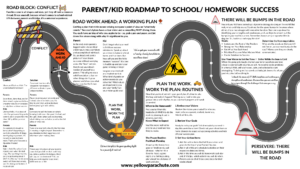As promised in last week’s post on conquering the self-defeating stories we tell ourselves, what follows is an honest and thorough accounting of what happened with those checklists I delegated to my kids to keep their home/school/hockey/dance obligations in balance.
The good news? We’re in our 8th week and all three kiddos have been able to make it onto the bus without me standing in the living room shouting commands—while I work away on blog posts and ways to teach our students how to learn in my full happiness and glory! Without my frenzied frustration, the mornings are a little more peaceful for everyone. And since I’m no longer playing the part of Executive Function police, my kids are developing their own self-regulation abilities in their prefrontal cortexes. Hooray! Science! Breakfast! Coffee! More Coffee!
The okay news? As happens in most families, the kids (and grownups) who need the list most are using it least, and the ones who need it least are using it most. We’ll keep working on that. In fact, I’m excited about this room for improvement. Why? Because what’s not working is an important—essential—part of the learning process. As parents and educators, we need to persist when the novelty has worn off, just when the plan looks like it may fail. This gap between our first try and our ideal outcome is where growth happens.
So this ever-persistent (i.e. stubborn) Coach. Student. Teacher. Visionary. Mum. has kept on the path of making our list work for ALL members of our family. The trick is knowing how the list serves each individual’s WHY.
First I needed to think about my why in persisting with this list: what do I want to achieve by creating and enforcing it? I won’t lie, I momentarily liked the idea of molding our kids into little housework robots, like Roombas with legs and silent opinions. But my goal as a parent is to help them become faithful, successful human beings in a steady state of becoming and achievement, all with the aim of developing their gifts and interests to serve others. That’s a mouthful.
A goal like that takes great thought. Because each of my kids is a unique individual with experiences, histories, and perceptions (personal narratives) all their own, they’re each going to need a different pathway to flexing these muscles in the learning process. And I want them to write their own stories. So how can a simple (and somewhat intense) checklist help in this larger-than-life mission?
My kids (most kids) won’t do the list simply because it’s there (though that would be delightful) and I don’t really want robots capable of executing tasks on command without questions (though there’s a hint of gloriousness there do you see it?). I want to guide capable, flexible thinkers who engage their goal-oriented persistence to get what they need out of life. To do what they need to do in order to get to what they want to do.
And some of these tasks are pretty boring. Who likes wiping bathroom counters? Or vacuuming? So to develop the vision for “hard work pays off,” they need little bolts of inspiration, benchmarks, and rewards along the way to break the long list into manageable chunks.
How did I solve the problem of the under-used checklist? I retraced my steps. I looked for bottlenecks in the routine and thought about ways to reward behaviors that helped push through those bottle necks. I asked: What are the human elements that guide our family routines, and what could inspire my kids to delay short-term gratification in the name of a long-term goal?
Charles Duhigg has given me some extremely helpful information on breaking and changing habits in his bestselling book The Power of Habitand newest publication Smarter, Faster, Better. I’m going to use it here to develop habits. In Smarter, Faster, Better, Duhigg compares habit building to muscle building—you must flex and develop over time. As an Alpha Strong and Metcon believer, this idea of weight training to build muscle aligns well with my idea of growth mindset and with Yellow Parachute’s definition of HOPE. It’s the best when worlds collide to inspire, isn’t it?
And the first step: make it easy. Start with a light weight. Establishing a habit begins by identifying a cue that triggers your new routine, as well as the anticipation of a specific reward for completing that new routine, like so:
CUE —> ROUTINE —> REWARD [REPEAT]
When I reviewed the patterns of our daily family tensions, I realized the scenarios where my kids and I squabble the most fell into three categories: FOOD. TIME. MONEY.
So here’s where I went with the list:
FOOD:
Instead of watching my kids waste minutes staring into the refrigerator looking for the mysterious pathway into another reality where long-johns and cinnamon rolls jump hot out of the oven into their mouths I asked them to list their desired (healthy) breakfast items on the checklist. I did this for snacks as well. I then listed their breakfast and snack choices in the left column across from their morning and afternoon jobs as a reminder of the yummy choices waiting for them at the start and end of their school days. This family collaboration also helped us create a more efficient grocery list. The food on their checklists reminds them that I’m on their side. This doesn’t have to be a tug of war. We can work together to make great things happen for our family.
TIME:
The liberty of free time is another incentive. At their various ages, each of my kids wants more time to listen to music, play with Legos and dolls, build forts, read, watch TV, play video games, and play outside alone or with friends. The rule is simple: when the house is picked up, friends are welcome any time. Free time can be used however they choose, but the work happens first.
MONEY:
The kids earn a monetary amount per day for the week when their to-do lists are done and checked off. No checks, no money. I keep the amount small so they see that hard work adds up over time. They each have different projects and objects on which they’d like to spend their cash, and it’s a way to help them appreciate the value of a dollar and the work that goes into earning it.
And so our family chugs through it checklists, adding miles of effort as we move towards the lives and selves we want to achieve. We know there will be bumps in the road, and that’s okay. Bump away, bumps! Our seatbelts are fastened and we’ve got our destination in mind.
-Cara
Psst. Want a look at the Braun-Thorpe family checklist? Here you go! Please do let me know if you find it helpful; send me a message if you’d like to know exactly how I use it.







